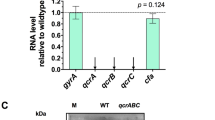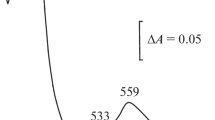Abstract
The respiratory activities of E. coli with H2 as donor and with nitrate, fumarate, dimethylsulfoxide (DMSO) or trimethylamine N-oxide (TMAO) as acceptor were measured using the membrane fraction of quinone deficient strains. The specific activities of the membrane fraction lacking naphthoquinones with fumarate, DMSO or TMAO amounted to ≤2% of those measured with the membrane fraction of the wild-type strain. After incorporation of vitamin K1 [instead of menaquinone (MK)] into the membrane fraction deficient of naphthoquinones, the activities with fumarate or DMSO were 92% or 17%, respectively, of the activities which could be theoretically achieved. Incorporation of demethylmenaquinone (DMK) did not lead to a stimulation of the activities of the mutant. In contrast, the electron transport activity with TMAO was stimulated by the incorporation of either vitamin K1 or DMK. Nitrate respiration was fully active in membrane fractions lacking either naphthoquinones or Q, but was ≤3% of the wild-type activity, when all quinones were missing. Nitrate respiration was stimulated on the incorporation of either vitamin K1 or Q into the membrane fraction lacking quinones, while the incorporation of DMK was without effect. These results suggest that MK is specifically involved in the electron transport chains catalyzing the reduction of fumarate or DMSO, while either MK or DMK serve as mediators in TMAO reduction. Nitrate respiration requires either Q or MK.
Similar content being viewed by others
Abbreviations
- DMK:
-
demethylmenaquinone
- MK:
-
menaquinone
- Q:
-
ubiquinone
- DMSO:
-
dimethylsulfoxide
- TMAO:
-
trimethylamine N-oxide
- DMS:
-
dimethylsulfide
- TMA:
-
trimethylamine
- BV:
-
benzylviologen
References
Ackrell BAC, Cochran B, Kearney EB, Cecchini G (1987) Redox properties of Escherichia coli fumarate reductase. In: Edmondson DE, McCormick DB (eds) Flavins and flavoproteins. Walter de Gruyter, Berlin, pp 691–694
Bilous PT, Weiner JH (1985) Proton translocation coupled to dimethylsulfoxide reduction in anaerobically grown Escherichia coli HB101. J Bacteriol 163:369–375
Bode CH, Goebell H, Stähler E (1968) Zur Eliminierung von Trübungsfehlern bei der Eiweißbestimmung mit der Biuretmethode. Z Klin Chem Klin Biochem 5:419–422
Cammack R, Patil DS, Condon C, Owen P, Cole ST, Weiner JH (1985) In: Bray RC, Engel PC, Mayhew SG (eds) Flavins and flavoproteins. Walter de Gruyter, Berlin, pp 551–554
Dickie P, Weiner JH (1979) Purification and characterization of membrane-bound fumarate reductase from anaerobically grown Escherichia coli. Can J Biochem 57:813–821
Driessen AJM, deVrij W, Konings WN (1986) Functional incorporation of beef-heart cytochrome c oxidase into membranes of Streptococcus cremoris. Eur J Biochem 154:617–624
Graf M, Bokranz M, Böcher R, Friedl P, Kröger A (1985) Electron transport driven phosphorylation catalyzed by proteoliposomes containing hydrogenase, fumarate reductase and ATP synthase. FEBS Lett 184:100–103
Guest JR (1977) Menaquinone biosynthesis: Mutants of Escherichia coli K-12 requiring 2-succinylbenzoate. J Bacteriol 130:1038–1046
Guest JR (1979) Anaerobic growth of Escherichia coli K12 with fumarate as terminal electron acceptor. Genetic studies with menaquinone and fluoro-acetate-resistent mutants. J Gen Microbiol 115:259–271
Holländer R (1976) Correlation of the function of demethylmenaquinone in bacterial electron transport with its redox potential. FEBS Lett 72:98–100
Ingledew WJ, Poole RK (1984) The respiratory chains of Escherichia coli. Microbiol Rev 48:222–271
Kröger A, Klingenberg M (1973) The kinetics of the redox reactions of ubiquinone related to the electron transport activity in the respiratory chain. Eur J Biochem 34:358–368
Kröger A, Unden G (1985) The function of menaquinone in bacterial electron transport. In: Lenaz G (ed) Coenzyme Q. John Wiley, Chichester, pp 285–300
Kröger A, Dadák V, Klingenberg M, Diemer F (1971) On the role of quinones in bacterial electron transport: Differential roles of Ubiquinone and Menaquinone in Proteus rettgeri. Eur J Biochem 21:322–333
Lenaz G (1988) Role of mobility of redox components in the inner mitochondrial membrane. J Membrane Biol 104:193–209
Mannheim W, Stieler W, Wolf G, Zabel R (1978) Taxonomic significance of respiratory quinones and fumarate respiration in Actinobacillus and Pasteurella. Int J Syst Bacteriol 28:7–13
Meganathan JR (1984) Inability of men mutants of Escherichia coli to use trimethylamine N-oxide as an electron acceptor. FEMS Microbiol Lett 24:57–62
Miller JH (1972) Experiments in molecular genetics. Cold Spring Harbor Laboratory, Cold Spring Harbor, New York
Morningstar JE, Johnson MK, Cecchini G, Ackrell BAC, Kearney EB (1985) The high potential Iron-Sulfur-Center in Escherichia coli fumarate reductase is a three-iron cluster. J Biol Chem 260:13631–13638
Polglase WJ, Pun WT, Withaar J (1966) Lipoquinones of Escherichia coli. Biochim Biophys Acta 118:425–426
Schnorf U (1966) Thesis, No. 3871, ETH, Zürich
Takagi M, Tsuchiya T, Ishimoto M (1981) Proton translocation coupled to trimethylamine N-oxide reduction in anaerobically grown Escherichia coli. J Bacteriol 148:762–768
Unden G (1988) Differential roles for menaquinone and demethylmenaquinone in anaerobic electron transport of E. coli and their fnr-independent expression. Arch Microbiol 150:499–503
Unden G, Albracht SPJ, Kröger A (1984) Redoxpotential and kinetic properties of fumarate reductase complex from Vibrio succinogenes. Biochim Biophys Acta 767:460–469
Unden G, Duchene A (1987) On the role of cyclic AMP and the Fnr protein in Escherichia coli growing anaerobically. Arch Microbiol 147:195–200
Unden G, Hackenberg H, Kröger A (1980) Isolation and functional aspects of the fumarate reductase involved in the phosphorylative electron transport of Vibrio succinogenes. Biochim Biophys Acta 591:275–288
Unden G, Böcher R, Knecht J, Kröger A (1982) Hydrogenase from Vibrio succinogenes, a nickel protein. FEBS Lett 145:230–234
Wallace BJ, Young IG (1977) Role of quinones in electron transport to oxygen and nitrate in Escherichia coli. Biochim Biophys Acta 461:84–100
Weiner JH, MacIsaac DP, Bishop RE, Bilous PT (1988) Purification and properties of Escherichia coli dimethylsulfoxide reductase, an iron-sulfur molybdoenzyme with broad substrate specificity. J Bacteriol 170:1505–1510
Whistance GR, Threlfall DR (1968) Effect of anaerobiosis on the concentrations of demethylmenaquinone, menaquinone and ubiquinone in Escherichia freundii, Proteus mirabilis and Aeromonas punctata. Biochem J 108:505–507
Author information
Authors and Affiliations
Rights and permissions
About this article
Cite this article
Wissenbach, U., Kröger, A. & Unden, G. The specific functions of menaquinone and demethylmenaquinone in anaerobic respiration with fumarate, dimethylsulfoxide, trimethylamine N-oxide and nitrate by Escherichia coli . Arch. Microbiol. 154, 60–66 (1990). https://doi.org/10.1007/BF00249179
Received:
Accepted:
Issue Date:
DOI: https://doi.org/10.1007/BF00249179




